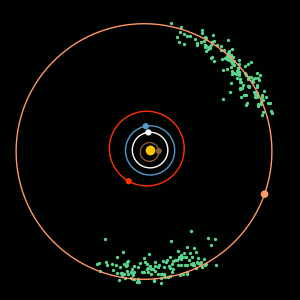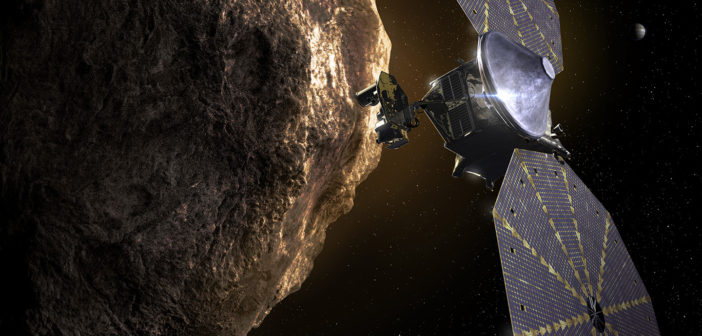Next year, the Lucy space probe will launch on a journey to visit several asteroids in our solar system. One of its destinations, 3548 Eurybates, has recently been discovered to harbor a satellite — providing Lucy with a new target to explore.
A Trojan Population

Animated figure illustrating the orbits of the inner planets, Jupiter (orange disk and orbit), and Jupiter’s trojan asteroids (green disks). The trojans fall into two camps: the Greek camp (the cluster leading Jupiter) and the Trojan camp (the cluster trailing Jupiter). [SwRI]
The Jupiter trojans are ancient vestiges of our solar system’s formation — leftover building materials from the construction of the outer planets. Scientists hope that by examining the composition, structure, and dynamics of these time capsules, we’ll learn more about the history of our solar system and the origin of organic materials on Earth.
Getting Up Close and Personal
So far, we’ve detected around 7,000 Jupiter trojans, and we now hope to get a better look at these small, distant bodies. This is where Lucy comes in: this upcoming NASA space probe, slated to launch in October 2021, will fly by six different Jupiter trojan asteroids over the span of six years (2027–2033), providing us with up-close views of these fossils of planet formation.
To prepare for Lucy’s launch, the next step is to characterize the mission’s targets, thereby ensuring that we can plan the spacecraft’s route and observing schedule effectively and efficiently. To this end, a team of scientists led by Keith Noll (NASA Goddard SFC) recently examined one of Lucy’s targets, the trojan asteroid 3548 Eurybates, using the Hubble Space Telescope — and they found more than they bargained for.

This 2” x 2” view of Eurybates from Hubble in January 2020 confirmed the presence of a satellite, identified here by a green circle. [Adapted from Noll et al. 2020]
Pixel Hunting
Noll and collaborators first spotted hints of a satellite body near the 64-kilometer-diameter Eurybates in two sets of Hubble images from September 2018. A 1.7-pixel blip was visible next to Eurybates in both observations, and it shifted location between the two images — an indication this was a blip worth follow-up.
But it’s tough to get follow-up time on one of the world’s most popular telescopes! The team was granted just three opportunities with Hubble to try to confirm this possible satellite. The first two attempts, made in December 2019, failed — the satellite was likely too close to Eurybates to be resolved. But in the third set of observations, the blip reappeared — a faint observation that allowed Noll and collaborators to confirm the presence of a ~1.2-km satellite for Eurybates.
Time to Study Some Collisions

The relative size of known satellite/asteroid pairs in the solar system, plotted against their orbital distance. Symbol sizes are proportional to satellite diameter. Eurybates (blue symbol) is one of the smallest and most distant primaries for which a satellite has been detected from an Earth-based telescope. Click to enlarge. [Noll et al. 2020]
The properties of this system suggest the satellite was formed from Eurybates by a collision — providing us with a golden opportunity to study a collisional satellite at close range. With seven years to go before Lucy’s close encounter with Eurybates, we’ve got time to learn more and prepare!
Bonus
Curious how Lucy’s going to manage to visit six different targets, all in one journey? Click below to check out a video from SwRI (or visit the SwRI website directly, if it doesn’t play in your browser) that shows Lucy’s complex planned orbit.
Citation
“Detection of a Satellite of the Trojan Asteroid (3548) Eurybates—A Lucy Mission Target,” K. S. Noll et al 2020 Planet. Sci. J. 1 44. doi:10.3847/PSJ/abac54

